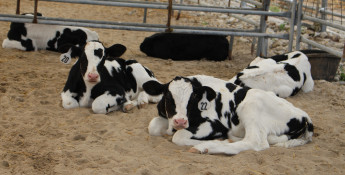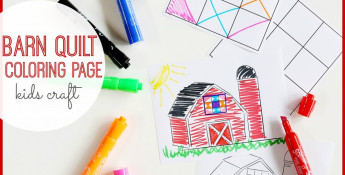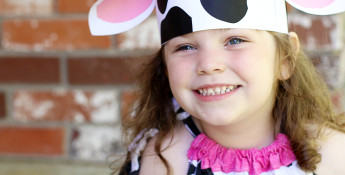By Rick McNary on May 2, 2016
Milking a cow...with a robot
Yep, with a robot!

The milk cows on Meier’s Dairy are unusual; they decide when to be milked rather than being forced to adapt to a schedule. Since robotic milking machines were installed, some cows now choose to be milked five or six times a day.
“We used to milk three times a day because cows produce more if they are milked every eight hours,” Duane Meier explained. “But we had such a hard time maintaining a labor force that we dropped it to twice a day. Our decision to go with robots was based on the challenges and costs of labor. Since we installed the robots, our labor costs are cut in half and milk production increased 25 percent.”
Duane’s great-grandfather homesteaded near Palmer in the late 1800s, hand-milking cows into a bucket. The dairy transitioned to Duane’s father, and then Duane and his wife, Ronda, purchased it from him. The dairy now milks more than 650 cows each day and four of their five children work on the dairy with them.
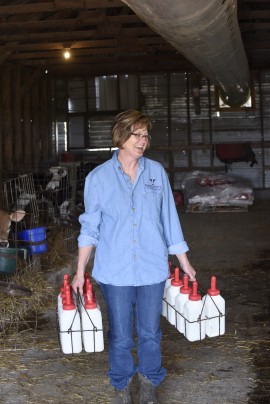 “I couldn’t bear the thought of looking out our picture window and not seeing any cows in the pen or that they belonged to someone other than us or our children,” Ronda said. “But I knew if we didn’t move to robotics, we would eventually have to sell out.”
“I couldn’t bear the thought of looking out our picture window and not seeing any cows in the pen or that they belonged to someone other than us or our children,” Ronda said. “But I knew if we didn’t move to robotics, we would eventually have to sell out.”
They first saw robots at the World Dairy Expo in Wisconsin. Making the decision to switch to robots was easy; the hard part was finding a company to sell them robots.
“We kept calling two companies, but they couldn’t help us because they didn’t have dealerships near us,” Ronda said. “I finally got on Lely’s Facebook page and messaged them, ‘Please, please, please sell us your machines.’ Someone finally listened and they put the wheels in motion to set up a dealership.”
Robotic milkers, known as automated milking systems (AMS), were developed in Europe and began commercial application in the 1990s.
“Before my Dad passed away he had Alzheimer’s, but I still talked to him about activities on the dairy,” Duane said. “One day, I told him I was nervous about the decision to switch to robots and Dad said to me, ‘Duane, I can see it in your eyes that you’re going to make this work.’ That’s helped me through the dark days when I wasn’t sure we made the right decision.”
When the Meiers first began talking to robotic companies at the Expo, those companies wanted them to build new barns. However, the Meiers had recently built two barns and weren’t interested in building more. Eventually, the company allowed them to retrofit their barns for the equipment.
“After they were installed, we had to train the cows to use them,” Duane said. “We walked around the pens 24-hours-a-day for the first five days and led the cows to the robots. Our family, neighbors and students from K-State took turns with 10-hour shifts. According to our pedometers, we walked 10 miles per shift; it was a great weight-loss program for me.”
Although the initial learning curve was steep, the Meiers admit the cows are now training them.
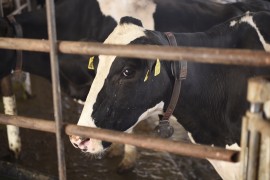 Each cow wears a collar that transmits various data to a central computer. The computers are monitored in the main office and every eight hours a list is generated of cows that haven’t been milked. They then find those cows and lead them to the robots.
Each cow wears a collar that transmits various data to a central computer. The computers are monitored in the main office and every eight hours a list is generated of cows that haven’t been milked. They then find those cows and lead them to the robots.
“Now that we have the robots, the personalities of the cows really come out,” Ronda said. “They are more mellow which means the barns are much quieter; we just don’t hear them bellowing like we used to. We also learned the cows prefer not to be disturbed. We left the lights on one night and they didn’t like it. It was like they said, ‘Turn the lights off and leave us alone.’ Another time, we had an open house for 200 people and production dropped.”
The Holstein breed comprises a majority of the herd, although some of the children favor the Jersey breed. One of each breed faces the other on the Meier’s Dairy sign with the motto, A Farm Divided. Ronda points out the phrase refers to the breed of cows, not conflict in the family.
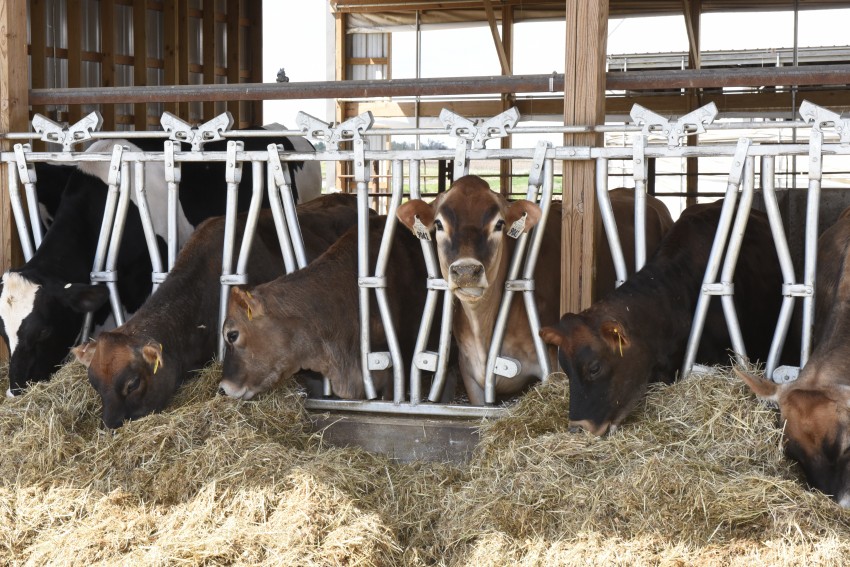 “We call the Jerseys, our little piggies,” Duane joked. “They love to eat so they’ll go into the stanchion just to eat, but the robot recognizes they are not giving milk, so it shuts off the feed and opens the gate. The Jerseys go around and try it again and the robot shuts off the feeder and opens the gate. The computer showed us that one cow recently tried it 15 times before she gave up.”
“We call the Jerseys, our little piggies,” Duane joked. “They love to eat so they’ll go into the stanchion just to eat, but the robot recognizes they are not giving milk, so it shuts off the feed and opens the gate. The Jerseys go around and try it again and the robot shuts off the feeder and opens the gate. The computer showed us that one cow recently tried it 15 times before she gave up.”
The move away from the intense labor of milking each day created new opportunities for specialization. While Duane and Ronda provide the oversight, each of their children are able to focus on certain niche areas such as robot technology, herd management, breeding, genetics, feed technology and other business components.
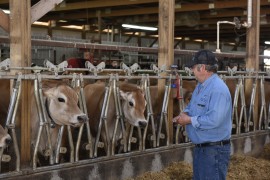 “One difference we appreciate is that we have the chance to teach our children more,” Duane explained. “When they were growing up, it was often easier to tell the hired help to go do something rather than taking the time to show our kids. Now we have more time to train them.”
“One difference we appreciate is that we have the chance to teach our children more,” Duane explained. “When they were growing up, it was often easier to tell the hired help to go do something rather than taking the time to show our kids. Now we have more time to train them.”
Between two of the barns, toy farm implements are scattered in a large sand pile, evidence of the grandchildren that now spend time on the dairy.
“Our children had the chance to work away from the farm before deciding to return,” Ronda said. “At Christmas last year, every memory our kids shared revolved around milking cows. We can’t imagine doing anything else.”
“And I’m not smart enough to do anything else,” Duane jokes.
Most family farms in America face the challenge of keeping the farm in the family. For the Meier family, the transition requires thinking differently. Adapting to the latest technology ensures their grandchildren playing with toy tractors in the sand can create their own milk cow memories.
Want to learn more about the Meier's Dairy? Check out this video!
Want to learn more about dairy cows? Check this out:
Looking for more fun crafts?

